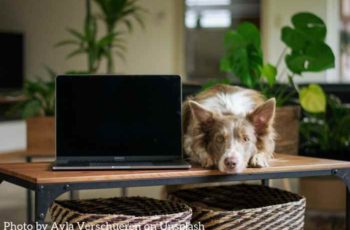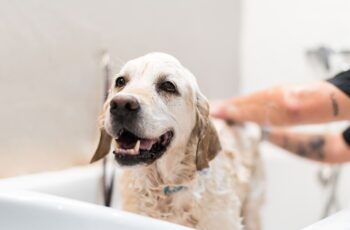Does your otherwise well-house-trained dog pee when you walk in the door and greet her, or when other people reach to pet her? Yikes! Submissive and excitement urination can be very frustrating behaviors to live with; having to constantly mop up puddles and spray enzymatic cleaners on your carpet can get old fast.
The three most important things to know about submissive peeing and excitement peeing are:
- They aren’t gender-biased; they happen with both male and female dogs.
- Your dog can’t help it!
- Punishment (or even mild disapproval) will only make it worse.
What is excitement urination?
Excitement urination (also known as “glee pee”) is most often found in happy, hyper, young dogs who may not yet have developed full bladder control. Dogs frequently outgrow this unfortunate peeing behavior as they mature, emotionally calm down, and gain better control of their bladders. Meanwhile, if the dog who exhibits lots of excitement behavior is well managed, it’s usually just a matter of waiting a few months (or a few more) for him or her to mature.
Here’s what good management of excitement urination looks like in this case to help stop your dog’s excitement urination:
Provide plenty of aerobic exercise. This means off-leash running around, chasing a ball or flying disc, rough-and-tumble play with an appropriate canine play-pal, lots of “sniffari” opportunities, as well as ample time spent with toys and cognition games that provide mental enrichment. Boring old walks on leash, regardless of how long, just aren’t going to do the trick. (For examples of good enrichment toys, see “The Best Food-Dispensing Toys” WDJ April 2019. For other ideas for games to play with your dog, see “Are Canines Cognitive?” October 2017.)
Train calm behaviors. Teach your dog behaviors that encourage calm, such as “Settle,” “Relax,” or “Go to Your Mat.”
The “Karen Overall Protocol for Relaxation” is another great resource for helping your dog learn how to relax. Complete directions for the protocol can be downloaded at this link: https://bit.ly/Pryor_relax.
Set a calm example. The better you are at being calm with your dog, the easier it will be for her to be calm with you. Quiet, low-key greetings when you come home and an overall peaceful ambiance in the house can minimize glee-pee accidents. Save the excited, high-energy activities for outdoors, where an occasional excitement puddle won’t matter.
No punishment, ever. Remember, your dog can’t help it. If you lose your cool with her over her excitement urination you could end up with a dog who is afraid of you and submissively urinates, a behavior that can be a lot more challenging to modify than adolescent excitement urination. Count your blessings.
What is submissive urination?
While a challenging and frustrating behavior to live with, submissive urination is – among dogs, anyway – a valuable canine communication tool. A dog who feels threatened by another can often successfully deflect the threat by displaying submission or appeasement behavior, with a lowered behind-the-vertical body posture, flattened ears, squinty eyes, and tucked tail. Sometimes this includes rolling onto their back and submissive urination.

It stands to reason that any angry response or punishment on your part is likely to make the behavior worse, not better, as your dog tries even harder to appease you and deflect the threat. Here’s how to respond appropriately instead to help stop submissive urination:
Approach in a non-threatening manner. Even if you don’t intend to be imposing, if you stand tall, face your dog, stride forward, make direct eye contact and/or lean over her, you can be perceived as a threat. Instead, kneel sideways to greet your dog and let her approach you. And coach all your friends and family members to do the same!
Reach under, not over. Humans seem to have a predilection for patting dogs on top of their heads. A few dogs might actually like this, and a fair number of dogs tolerate it. However, for most dogs, reaching over their heads is at least somewhat aversive – and this is especially true for dogs who are prone to submissive urination because they are already concerned about humans.
Educate yourself to scratch dogs under the chin or on the chest instead of reaching for their heads. Many dogs will appreciate it – and any dog prone to submissive urination will be less likely to urinate.
Move calmly and slowly. The calmer you (and your friends) are around your dog, the less likely she is to feel the need to send that appeasement-pee message.
Manage the pee. Doggie diapers can be a useful stress-reducing management tool while you are working to help your dog overcome the need to pee when greeted. They may not stop the urination, but they can help prevent you from getting annoyed at your dog and minimize puddle clean-up.
Even if you don’t punish your dog for inadvertently urinating, she can read any stressed or tense body language signals that you make in response to the mess; this will send her the message that she needs to be even more appeasing – and release even more pee!
Let your dog greet visitors outdoors. That way, if she does involuntarily urinates, there’s no clean-up needed, and no human stress.
Use counter-conditioning and desensitization in the situations that trigger her urination. Begin by identifying situations that typically elicit submissive urination from your dog. Then, start counter-conditioning her to less-stressful approximations of those situations.
For example, if your dog often pees when you reach toward her, move your hand just slightly toward her, and feed (or toss) her a treat from your other hand. Once your dog is comfortable (with no urinating) with small movements, gradually increase the amount of your reach toward her.
You don’t need to use a marker (such as the click of a clicker or the word “Yes!”); you are not reinforcing her behavior. Rather, you are working to change her emotional response to the stimulus from scared or apprehensive to relaxed and happy. Eventually, you’ll be able to reach for your dog and even pet her (under the chin, not on the head) without a drop of pee on the floor.
Having trusted friends do the same thing so she generalizes her new association (“People reaching for me make treats happen!”) to other people, too. Meanwhile, do the same to counter-condition her with any other human behaviors that prompt her to submissively urinate.
Stay positive to achieve success in preventing submissive urination
As challenging and frustrating as these involuntary peeing behaviors can be, you can help your dog overcome them. When we adopted Bonnie, our wonderful Scottie/Corgi/Poodle-mix at the age of 11 months (after her owners surrendered to a shelter because they “couldn’t housetrain” her), she almost always urinated when greeting humans. My husband and I both worked to counter-condition and desensitize Bonnie to greetings and interactions with humans – and my dog-training academy students got extra credit points if they could greet Bonnie without making her pee! She stopped all submissive urination by the time she was 3 years old and never did it again for the remaining 10 years of her life. You and your dog can do this!


